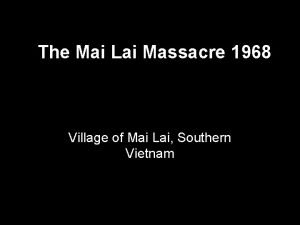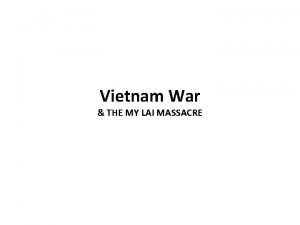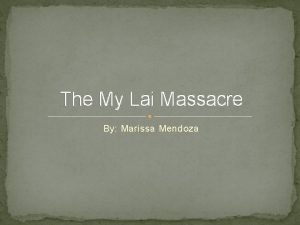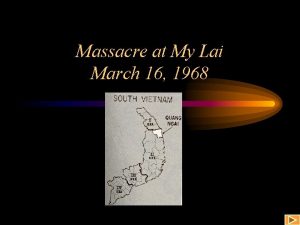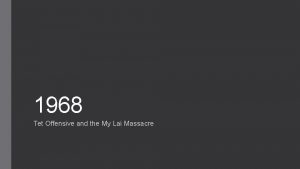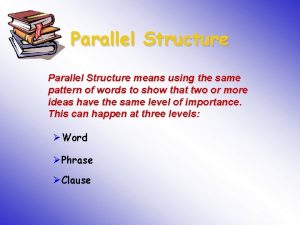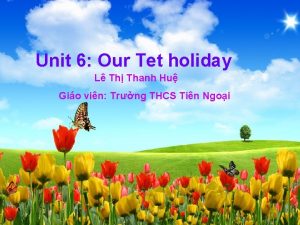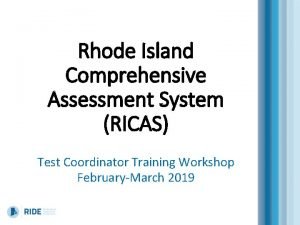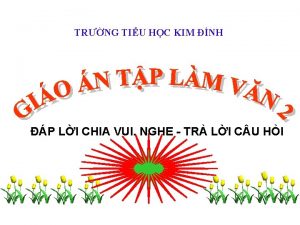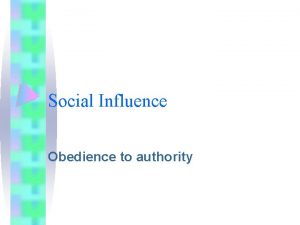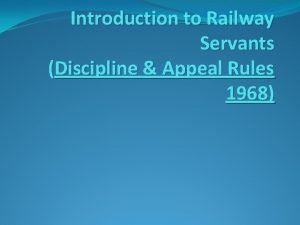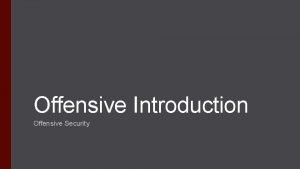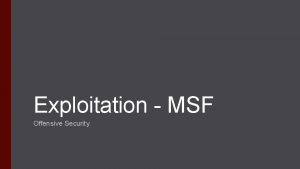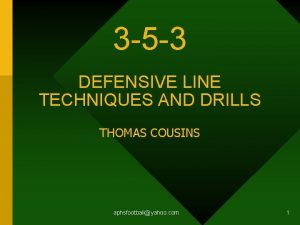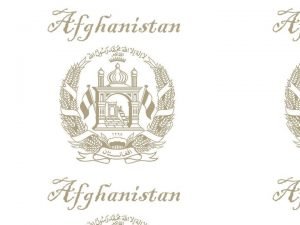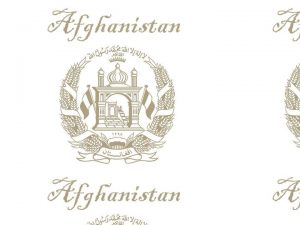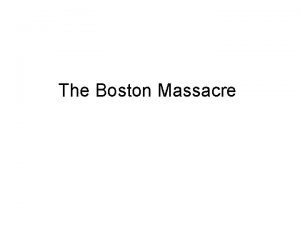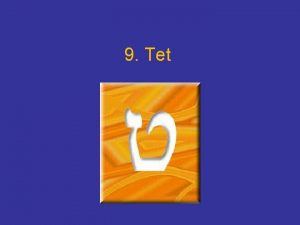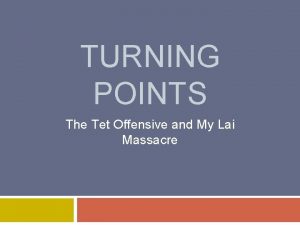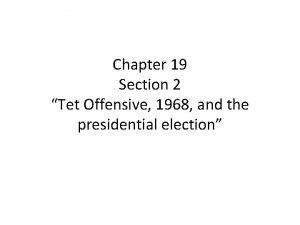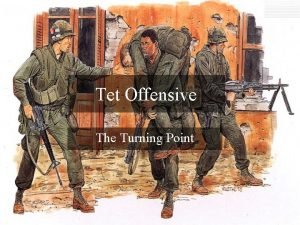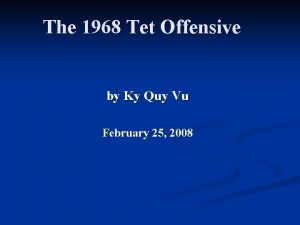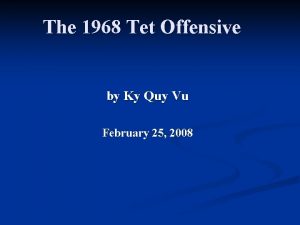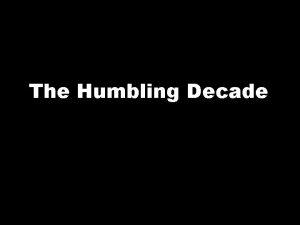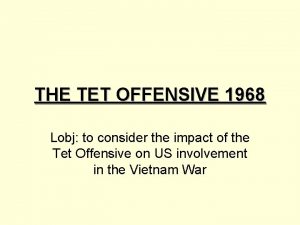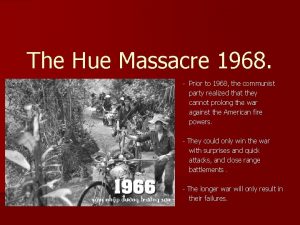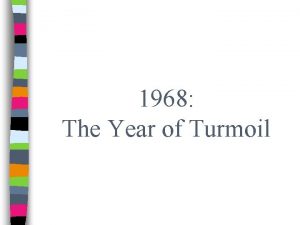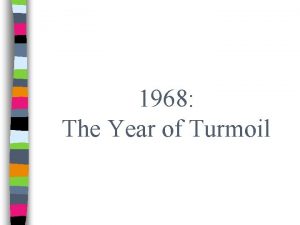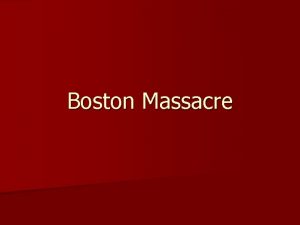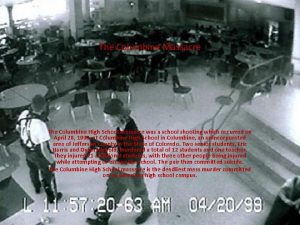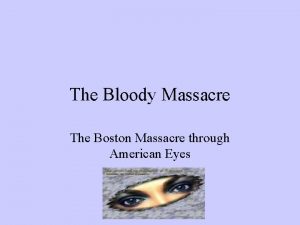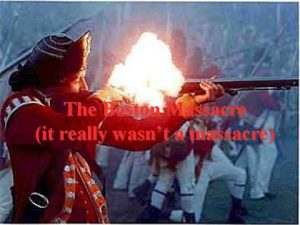1968 Tet Offensive and the My Lai Massacre






























- Slides: 30

1968 Tet Offensive and the My Lai Massacre

Background • Vietnam war was from 1959 -1975 • US involved from 1965 -1973 • Includes Vietnam, Laos, and Cambodia • Total deaths – about 1. 5 million 58, 000 American soldiers died

Why was the US Involved? • 1954 – Vietnam was divided in half North – communist South – democratic • 1965 – US gets involved Sends in troops to the South Wants to keep the South’s government from collapsing

Tet Offensive

Lead up to the Tet Offensive • 1965 -1967: US dramatically increased the number of military advisers Lead to increased anti-war protests in America US government claimed progress was being made

Khe Sanh • January 21, 1968 20, 000 NVA troops attack Khe Sanh NVA under the command of General Giap Khe Sanh was an isolated American air base, about 14 miles from the northern border 5, 000 US Marines were surrounded along with South Vietnamese forces Siege lasted 77 days US mounts counterattack and pushes NVA back At home, protestors were comparing this to Dien Bien Phu


General Giap’s Plan • US focus was on Khe Sanh was a diversion • General Giap knew people were protesting the war in the US Media attention was becoming a key factor • Giap wanted to start an uprising amongst the South Vietnamese against US involvement

General Giap’s Plan • Engage in a bloody conflict that would further enrage Americans Thinks this will break the desire of the US government to carry on • Needs a quick and decisive victory Ideally leading up to the 1968 Presidential Election in America

What is Tet? • Lunar New Year Called “Tet” in Vietnamese Most important and popular holiday in Vietnam Usually a three day holiday, towards the end of January

Tet Holiday Truce | 1968 • Truce was declared on both sides Soldiers would celebrate with families • NVA and VC began sneaking into cities with smuggled weapons Hid weapons in flower carts, coffins, and vegetable trucks Disguised themselves as peasants, refugees and workers

Tet Offensive Begins • January 31, 1968 84, 000 VC guerillas aided by NVA Attacks more than 100 cities and towns in the South Aided by the element of surprise because of the Tet Holiday Truce • Targets 35 of 44 provincial capitals Saigon – capital of South US Embassy in Saigon

Battle for Saigon • 1968: January 3 – March 7 35 NVA and VC units 50 US and Allied units US and Allies are able to keep Saigon from being taken

Attack on the US Embassy • January 31, 1968 19 VC soldiers blew their way into the US Embassy VC killed 2 of 5 MP’s Attack fails – VC were pinned down by Marine guards All 19 VC were killed

Battle for Hue • January 31 – March 2 12, 000 NVA and VC storm this historic city Hue is not well defended US and South forces counter-attack Heaviest fighting of the entire Tet Offensive


Massacre in Hue • More than 3, 000 “enemies of people” executed by VC and NVA in Hue Including SV government officials, SV officers, and Catholic priests Mass graves were found: people were tortured and sometimes buried alive Estimates might be closer to 6, 000 executed

Tet Offensive – The Big Picture • Turning Point of the War Protests in America increased greatly as a result Psychological victory for the NVA and VC • “Credibility Gap” Americans had been told the US was winning in Vietnam Tet Offensive showed differently Americans don’t trust LBJ or General Westmoreland • “The Living Room War” People watched the war in their homes Many saw first hand the assault on the embassy in Saigon The next image is one of the most famous images from the war


1968 | AP Photo • Chief of Police of Saigon, Nguyen Ngoc Loan Shown executing a suspected VC officer in Saigon • Eddie Adams, the photographer Won a Pulitzer Prize Said the man Loan shot had been seen killing others and felt the execution was justified

Walter Cronkite – February 27, 1968 • “For it seems now more certain than ever, that the bloody experience of Vietnam is to end in a stalemate. ” Cronkite was a well-respected anchorman for CBS • “That’s it. If I’ve lost Cronkite, I’ve lost middle America. ” President Johnson’s quoted response after watching Cronkite’s broadcast

Political Fallout of Tet • March 31, 1968 President Johnson announced he would not seek another term • 1968 The bloodiest year for US troops in Vietnam • Anti-War Movement Tet helped unite those at home who disagreed with the war Movement gained strength, especially during the election of 1968 • The Tet Offensive really turns America against the war

Tet Offensive Video • http: //www. history. com/topics/vietnam-war/tet -offensive • 5 minutes – overview of Tet

My Lai Massacre

Background • March 16, 1968 My Lai is a small village in South Vietnam US soldiers of Charlie Company Told that dozens of VC troops were coming through the area Told by their captain that all people in My Lai were either VC members or sympathizers

What Happened? • Soldiers rounded up hundreds of civilians Many were raped, beaten, and/or tortured Many were then killed Between 347 and 504 civilians were killed

Casualties • Of those killed: Many were women and children Many were “suspected” to be enemy fighters by US soldiers Killed by firearms, grenades and bayonets

Haeberle Photos • Army photographer accompanying Charlie Company, took many photos, including these

Cover Up and Investigation • Despite the photos, this event was covered up until September 1969 (but wasn’t brought to the public’s attention until November 1969) • The photos were key evidence in the Army’s investigation • Ultimately, 26 soldiers were charged One was sentenced to life in prison (Lieutenant Calley), but only served 4. 5 months Army concluded there was a widespread failure of leadership, discipline and morale • Americans increased their demand for a withdrawal from Vietnam Still considered the worst case of American war atrocities

My Lai Summarized • https: //www. youtube. com/watch? v=VWchy 6 yk. Nn. Q • 9 minutes
 Mai lai village
Mai lai village The tet offensive
The tet offensive My lai massacre
My lai massacre Marissa lai
Marissa lai Mai lai massacre primary sources
Mai lai massacre primary sources Mai lai massacre primary sources
Mai lai massacre primary sources Kop chai lai lai
Kop chai lai lai ưu thế lai là gì
ưu thế lai là gì Tom has a beautiful wife a big house and
Tom has a beautiful wife a big house and Parallel structure means using the same pattern of
Parallel structure means using the same pattern of Means using the same pattern of words to show
Means using the same pattern of words to show Prisma tet
Prisma tet Waterston shunt
Waterston shunt Tet spell
Tet spell Classification of congenital heart disease
Classification of congenital heart disease Modified bt shunt
Modified bt shunt I tet
I tet Tet holiday slide
Tet holiday slide Un tét
Un tét Ricas ride
Ricas ride Bác hàng xóm sang chúc tết chỉ có em ở nhà
Bác hàng xóm sang chúc tết chỉ có em ở nhà Morris louis tet
Morris louis tet Nanopore
Nanopore Orne and holland
Orne and holland Discipline and appeal rules 1968
Discipline and appeal rules 1968 Atkinson & shiffrin 1968
Atkinson & shiffrin 1968 Intro to offensive security
Intro to offensive security Being zealous without being offensive means---
Being zealous without being offensive means--- Metasploit offensive security
Metasploit offensive security Defensive end drills
Defensive end drills Chapter 3 lesson 3 expressing emotions in healthful ways
Chapter 3 lesson 3 expressing emotions in healthful ways
